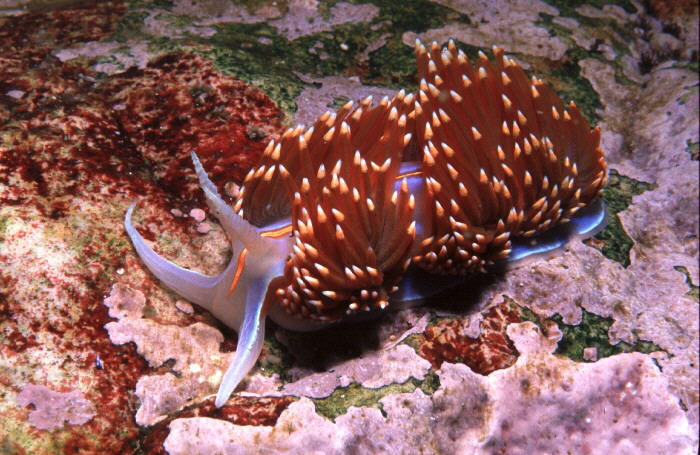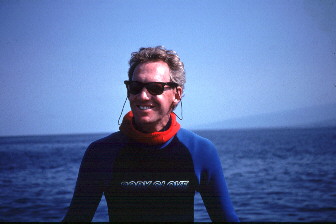 |
Hermissenda crassicornis
Photo courtesy of Dr. Marc Chamberlain
Hermissenda crassicornis (Eschscholtz, 1831)
Hermissenda crassicornis was featured as the Nudibranch of the Week way back in Week # 24 of this series. This species while possibly the most commonly observed species along the western coast of North America, it is also one of the most colorful. While ceratal color varies greatly between localities and sub-tidal habitats, it also differs between individuals depending upon their food resources. The most dramatic and consistent color feature is the distinctive iridescent blue lines on the body surface.
Marc's unbelievable 'in-situ' extreme close-up photo seen here shows, in spectacular detail, the morphology of this pigmentation. The blue pigmentation forms a line along the dorsal surface of the oral tentacles, which splits at the base of the rhinophores, one line following the edge of the foot to the tail, the other flanking the orange dorsal midline stripe.
While some research has been done on the chemical characteristics of this highly opaque, iridescent surface pigment, I was unable to locate any published details. Marc's photos give the impression that the pigment has been painted on the skin surface in a thick coat, and in no way penetrates the body tissue.
Definitely an aposomatic or warning mechanism for the nudibranch, a similar color band exists in Doriopsilla spaldingi Valdez and Behrens, 1998. The chemical composition of this pigmentation differs, however from that of Hermissenda (J. Lance, Pers. Comm.). In both cases, this pigment is a product of chemical synthesis - created by the animal from the chemical components of the food it preys upon. To me, the ability of this aeolid to create this iridescent blue from chemicals found in its hydroid prey is quite unbelievable.
The variety and flamboyancy of color in opisthobranchs is of course why each of us is so fascinated and drawn to this group of marine animals. The location (dermal, sub-dermal or within an organ such as the liver diverticula) of color pigments is of particular importance to opisthobranch systematists and natural products chemists. Whether the color is derived directly from the food preyed upon as in the sacoglossids, or chemically synthesized from the foods eaten, as in most species of nudibranchs, color serves a beneficial role to each species and must not be overlooked.
Bill Rudman's, The Sea Slug Forum contains an excellent review of Opisthobranch Defense Color, discussing camouflage, mimicry, warning color, deimatic color, counter shading and even species having the ability to change color.
As all of you know, most of the time we must look very close to even find most species of nudibranchs. To me, the real reward is looking even closer once I've located a specimen, as Marc has done here. Take the time to take a closer look and you will be amazed. It will open a whole new horizon to your wonder and enthusiasm about opisthobranchs.
Webmaster's Note: Marc's Hermissenda crassicornis pic above had the honor of being the lead image in our show on nudibranchs presented at the April, 1998 San Diego Underwater Photographic Society Film Festival!

Send Marc mail at marc.c.chamberlain@kp.org |
Taxonomic information courtesy of Dave Behrens
Photographs courtesy of Dr. Marc Chamberlain

David W. Behrens
Author:
Pacific Coast Nudibranchs
Send Dave mail at seachalleng@earthlink.net
|
